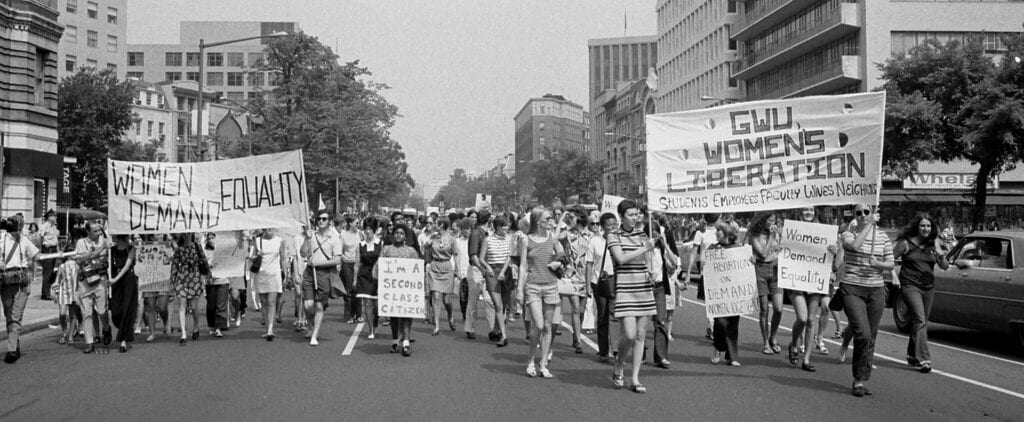The women’s rights movement, also called the women’s liberation movement, was a diverse social movement, largely based in the United States, that began in the 1960s and continued for two decades.
This period in history was referred to as the “second wave” of feminism. First-wave feminism started in the 19th century and continued into the early part of the 20th century. It focused primarily on women’s suffrage (the right to vote). Second-wave feminism broadened the debate to include a wider range of issues: sexuality, family, the workplace, reproductive rights, and legal inequalities. The women’s rights movement was focused on challenging male-dominated institutions and patriarchal cultural practices throughout society.
Among other things, the movement drew attention to the topics of domestic violence and marital rape. Changes were also made in custody laws and divorce law. Rape-crisis centers and women’s shelters came into existence as a result of the heightened awareness of these critical issues.

The term “second-wave feminism” was first introduced by journalist Martha Lear in a New York Times Magazine article in March 1968 titled “The Second Feminist Wave: What do These Women Want?” Lear stated in the article, “Proponents call it the Second Feminist Wave, the first having ebbed after the glorious victory of suffrage and disappeared, finally, into the great sandbar of Togetherness.”
In 1960, the Food and Drug Administration approved the oral contraceptive pill, which became available in 1961. This gave women many more choices, and freedom, in their personal lives. This made it easier for women to have careers without having to leave due to unexpectedly becoming pregnant. It also meant young couples would not be forced into unwanted marriages due to accidental pregnancies.
The 1960s was a decade of radical transformation for the role of women in the United States. Increasing numbers of women were entering the workforce and becoming dissatisfied with disparities in pay and advancement, coupled with the specter of sexual harassment. The women’s rights movement gained traction in the 1960s concurrently with the civil rights and anti-war movements. In 1963, Betty Friedan published her book, “The Feminine Mystique,” in which she claimed that “the problem that has no name burst like a boil through the image of the happy American housewife.”
Although TV shows like Leave it To Beaver and the Donna Reed Show portrayed an image of the delightfully-domesticated female, the truth was that huge numbers of American women worked outside the home.
By 1954 more women were in the workplace than during World War II. However, women’s pay was 60 percent of that of a male. Although The Equal Pay Act was passed in 1963, it did not address the pay in jobs that were classified as “female” jobs, such as teachers, nurses, and secretaries. The Civil Rights Act of 1964 prohibited employment and educational discrimination, thus making it possible for women to enter professional fields, though at a lower rate of pay than their male counterparts.
The National Organization for Women (NOW) was established in 1966 by a group of women including Betty Friedan and Pauli Murray, an author and women’s rights activist, who met to study strategies during the Third Annual Conference of Commissions on the Status of Women in Washington, D.C.
In 1967, NOW supported the passage of the Equal Rights Amendment (ERA), the repeal of abortion laws, and publicly-funded child care among its objectives in a document called the “Bill of Rights for Women.”
Rights that some women take for granted today are a result of the Women’s movement of the 1960s.
Banks could legally deny women credit cards until the 1974 Equal Credit Opportunity Act was passed. Women who tried to take a credit card out under their names were often denied or told them to obtain their husband’s signature. If the woman was single, the bank would request that she bring a male, such as her father or brother, to co-sign the application.
Until the 1973 Roe vs. Wade decision, women were not afforded reproductive rights.
Before the Pregnancy Discrimination Act of 1978, women could be fired because of pregnancy. Unfortunately, the act did not assure payment for time away from the job while pregnant, or that they could not be fired for “other” reasons once they became pregnant. The act merely prevented “pregnancy” as being a valid reason for termination.
Women were not allowed to attend a military academy or able to serve in a combat role in the military. West Point accepted its first female student in 1976, and women could fight in combat starting in 2013.
It was not until the 1970s that the courts started ruling on sexual harassment in the workplace. In 1977, the U.S. Circuit Court of Appeals for the District of Columbia pronounced that women could not be fired for refusing sexual advances from their bosses.
Women could not receive direct doctor’s consultations. A wife had to have her husband speak on her behalf for a myriad reasons; the most insulting reason was that women couldn’t “understand” what the doctors were saying.
Until the Violence Against Women Act of 1994, women were not legally protected from any act of violence from their husbands, including physical assault and rape. Before this act, many police departments around the United States believed any abuse from a husband towards his wife was a private family matter, and there was no such thing as marital rape.
Women had a difficult time being admitted to Ivy League universities. Yale became the first Ivy League college to admit women in 1969. After that, many other Ivy League colleges slowly followed. As a matter of fact, Columbia University didn’t allow women until 1983.
It was not until 1981 that a woman served as Supreme Court Justice. There have only been three other women to serve on the supreme court: Sonia Sotomayor, Elena Kagan, and Ruth Bader Ginsburg.
As illustrated by the preceding sample of rights not afforded to women before the women’s rights movement, it is clear that women today owe a debt of gratitude to the brave women of the 1960s.










